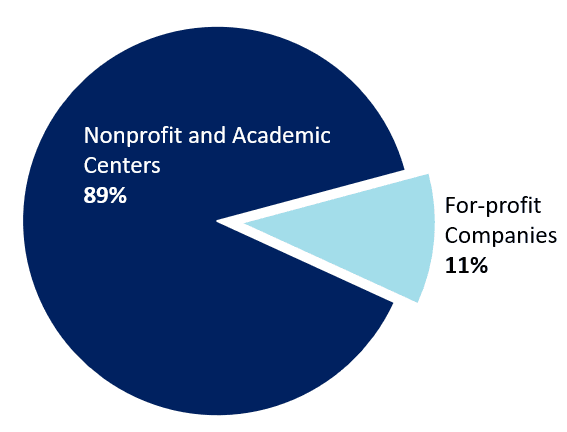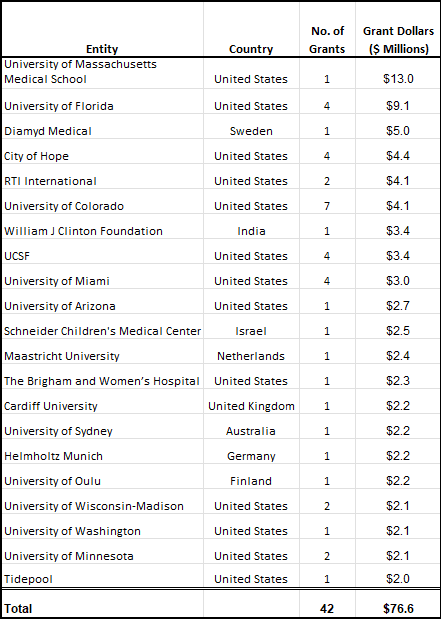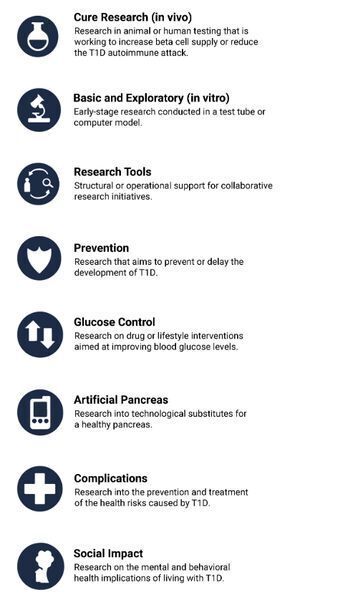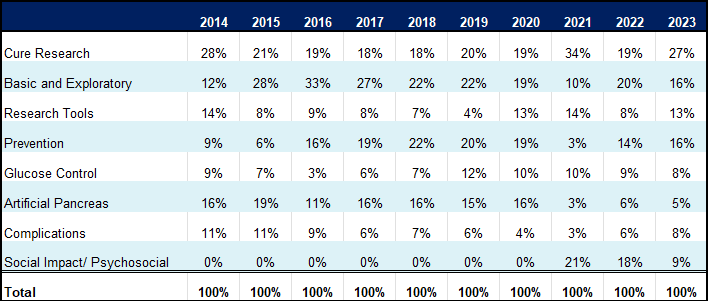At a Glance
- Breakthrough T1D distributed 157 new grants in FY23, totaling $146M to be given out over time.
- Zero funded research qualifies as a potential Practical Cure. This is a critical, missed opportunity.
- After taking a backseat for several years, prevention/onset delay grants grew substantially, even though delay is not a cure.
- Breakthrough T1D's coffer of unspent dollars is now $188M, an opportunity to invigorate cure research.
July 18, 2024
This is the 13th annual report reviewing the research grant funding by Breakthrough T1D, formerly JDRF. Breakthrough T1D is a powerhouse in the type 1 diabetes (T1D) landscape, providing millions of dollars annually for vital research grants. No other nonprofit organization is in a better position to deliver a Practical/Functional Cure for T1D, should it choose to make finding a cure a top priority. This report, by reviewing the types of research grants distributed by Breakthrough T1D, shows if a cure is or is not a priority.
The report reviews research grants fulfilled or contracted during the 2023 fiscal year (July 1, 2022–June 30, 2023). During FY23, Breakthrough T1D has 441 active grants as of publication with 157 new research grants. The total value of the 157 new grants given out during 2023 was $146 million, to be allocated over several years. The actual amount of money given to research grants during FY23, to new grants and grants from prior years, was $98 million.
JDCA staff reviewed research grants individually and categorized each one. Analyzing the new grants made during FY23 provides insight into how Breakthrough T1D uses its research budget, and which research areas are receiving the most or least attention.
Appendix A is an infographic with category definitions for reference. These categories are somewhat different than the ones used by Breakthrough T1D. We make this distinction to zero in on the projects that may provide a pathway to a Practical Cure and have progressed to testing in animals and/or humans (as opposed to computer simulations or test tube models).
All Breakthrough T1D grants are available for the public in the grant center. This public database is an excellent source of information for the T1D community and a strong example of information transparency.
Research Grant Priorities
Chart 1: Breakthrough T1D FY23 Research Grant Expenditure by JDCA Category (100% = $146 million)

Cure Research Top Billing but Still No Practical Cure
The top grant category in FY23 was in vivo research working toward a future cure. Nearly all of this research is in animal testing. While some of this work may be working towards a component of a complete Practical Cure, none present a full solution and there does not seem to be an urgency to do so.
This category received 27% of the year’s grant allocation (see chart 1). This is an increase from the prior year when the category received 19%, a similar level to most years of the past decade. However, in 2021, in vivo cure research grants received 34% of that year’s allocation, a level we hoped would continue.
The single largest cure research grant made in FY23 was $13 million. This grant was given to David Harlan at the University of Massachusetts for work toward beta cell replacement solutions.
Despite this positive expansion of in vivo cure research, there are zero Practical Cure research projects being funded. This is a critical point. It is both a major ‘miss’ and a major win-win opportunity. Practical Cure research is the number one priority of T1D donors based on surveys conducted over the past thirteen years. There is an opportunity for Breakthrough T1D to put in place a dedicated Practical Cure research initiative, to which people could give directly, pushing this research forward profoundly with speed while receiving incremental financial support from the community.
Prevention Returns to Second Priority alongside Basic Research
After a few years of lower priority, prevention returns as the secondary priority alongside basic and exploratory research. Each accounted for 16% of research grants made in FY23. However, there were nearly double the number of grants given to in vitro basic and exploratory research, at 39 grants, versus 22 grants for prevention. Accordingly, the average grant size for basic research was $591 thousand versus $1 million for prevention.
The majority of basic research and exploratory grants seek either beta cell regeneration or to stop the autoimmune attack. They are all early-stage, still in the laboratory. Many of these projects are truly exploratory, looking at new ideas and research approaches.
Many of the prevention grants seek to delay the onset of diabetes. Presumably, this follows the success and promise of Tzield, approved for market two years ago. Notably, the largest prevention grant was in the amount of $5 million given to Diamyd Medical, a for-profit company in human trials. Diamyd is testing a therapy to delay T1D onset in adolescents and adults who are recently diagnosed. This is the third-largest grant overall in FY23.
Our main issue with the return of delay and prevention as a key priority is that this does not address the needs of people suffering from T1D right now. Onset delay research, which is creating a sense of progress, does not ultimately stop the disease. While each year living without T1D is clearly valuable, delay is not a cure. We must resist the easier wins available in finding onset-delay solutions and pursue the harder but ultimately more important work of delivering a cure that can be applied to everyone with the disease, at any stage.
The Other Categories
All other categories received fewer dollars than the three noted above. Research tools, which received 13% of the total, is similar in relative importance versus prior years. The biggest grant in this category is an $8 million grant to nPOD, which has received strong support from Breakthrough T1D for many years. Glucose control and complications projects each received 8% of funding, similar to prior years. Social impact projects, highlighted as one of the fastest growing categories in prior years and appeared to mark a shift in strategy from cure-focused research to social projects (such as insulin access in developing countries), decreased in FY23 to 9%. The artificial pancreas category received the lowest allocation at 5%.
Nonprofit versus For-Profit Grants
Chart 2: Nonprofit versus For-Profit, % of Allocated Grant Dollars

The majority of grants given by Breakthrough T1D are to nonprofit institutions (see chart 2). In FY23, Breakthrough T1D made 13 grants to commercial, for-profit entities, accounting for 11% of the total dollar allocation; 89% were given to nonprofit organizations, including academic centers, independent research institutions, and other charitable organizations. These numbers do not include equity investments made by the T1D Fund, a fully-owned but independent subsidiary of Breakthrough T1D.
Among the dollars given to commercial enterprises in FY23, the top priority, receiving 39% of commercial grant dollars, were companies developing prevention or onset delay solutions. Diamyd, the prevention project discussed earlier in this report, was the biggest grant given to a commercial entity in FY23. After prevention, the next largest commercial categories, evenly split, were glucose control, artificial pancreas, and cure research.
One key question regarding commercial grants is the T1D Fund. Why does Breakthrough T1D give any grants to for-profit entities when it has a subsidiary that specializes in giving grants to for-profit entities? Grants are gifts and do not require any (or only minimal) future financial return in exchange for the grant. On the other hand, the T1D Fund does not give away money, it receives stock. Should the company be sold or begin making a profit, the T1D Fund receives a portion of the profits, usually many times larger than its original investment.
Institutional Grant Recipients
In FY23, 109 different entities received a research grant. Several received multiple grants, with the University of Colorado at the top spot with 7 grants. The average amount each entity was granted in FY23 was $1.3 million with a median grant size of $900 thousand.
The single largest dollar recipient was the University of Massachusetts followed closely by the University of Florida (see chart 3). In both cases, a single, large grant drove these top billings—beta cell replacement at the University of Massachusetts, nPOD, and the University of Florida. The third position goes to Diamyd, a commercial entity. It is worth noting that the 7th largest grant was given to the William Clinton Foundation for a social impact initiative. The list is truly international even if the majority of grants are to organizations in the United States.
Chart 3: Institutional Recipients of Grants Ranked by Dollars Received, FY23

COVID-Era Cash Build Up = Opportunity to Boost Cure Research
During COVID, Breakthrough T1D built up a historically huge pool of unspent dollars. Cost cutting during that period has led to a $188 million war chest as of FY23. About $100 million is held by the T1D Fund, a result of successful fundraising and profitable investment exits. The remaining $88 million is held by Breakthrough T1D. None of this money has yet to be deployed.
This presents a great opportunity.
Imagine if Breakthrough T1D used this stockpile to underwrite a dedicated initiative to boost and accelerate a Practical Cure for T1D, for people battling the disease each day. We’ve had great success in delaying T1D onset; this would give a material boost to driving success toward a Practical Cure for those of us who are well past diagnosis. A Practical Cure seems closer today than ever, but it will not be within our grasp unless it receives full focus.
Imagine what Breakthrough T1D could do if it deployed this cash to such a cure. We might just see the only breakthrough that really matters—a breakthrough to a Practical Cure. For those of us living with the disease today, that really is the only thing that would live up to the new name.
Appendix A: Research Grant Category Definitions

Appendix B: Breakthrough T1D Research Grant Spending Historic Trends by Category (as a Percent of Total Grant Funding)

